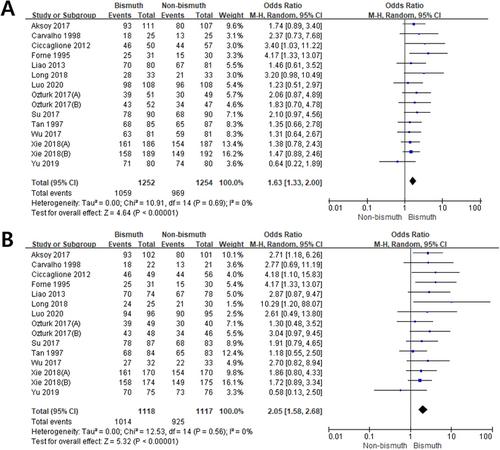Systematic Review and Meta-Analysis: Bismuth Enhances the Efficacy for Eradication of Helicobacter pylori
Abstract
Background
In the eradication of Helicobacter pylori, the efficacy of bismuth remains inconclusive. We aimed to compare the efficacy of bismuth on various H. pylori eradication regimens.
Methods
Randomized controlled trials were collected to compare the efficacy of bismuth to nonbismuth regimens in H. pylori eradication. We pooled information to study eradication, adverse events, and drug compliance. In addition, subgroup analyses for eradication efficacy were performed according to high or low clarithromycin-resistance area, bismuth drug form, and amount of bismuth element.
Results
Records for a total of 2506 patients in 15 trials from 13 randomized controlled studies were included. The eradication of H. pylori was superior when bismuth compared to nonbismuth regimen (odds ratio [OR] = 1.63, 95% confidence interval [CI], 1.33–2.00 in intention-to-treat [ITT]; OR = 2.05, 95% CI, 1.58–2.68 in per-protocol [PP] analyses), without significant difference in drug compliance or adverse events. Bismuth regimens in the high clarithromycin resistance area tend to enhance the eradication rate (OR = 1.66, 95% CI, 1.34–2.05 in ITT; OR = 2.22, 95% CI, 1.67–2.95 in PP analyses). Bismuth potassium citrate and bismuth subcitrate were more effective drug forms in regard to eradication rate. Bismuth at a dosage of < 500 mg/day was significantly higher for the eradication rate.
Conclusions
Bismuth to the H. pylori eradication regimens achieve a higher eradication rate, especially in the high clarithromycin resistance area. It could be an eradication option achieving sufficient resistance rates without increasing antibiotic resistance, side effects, or poor compliance.


 求助内容:
求助内容: 应助结果提醒方式:
应助结果提醒方式:


